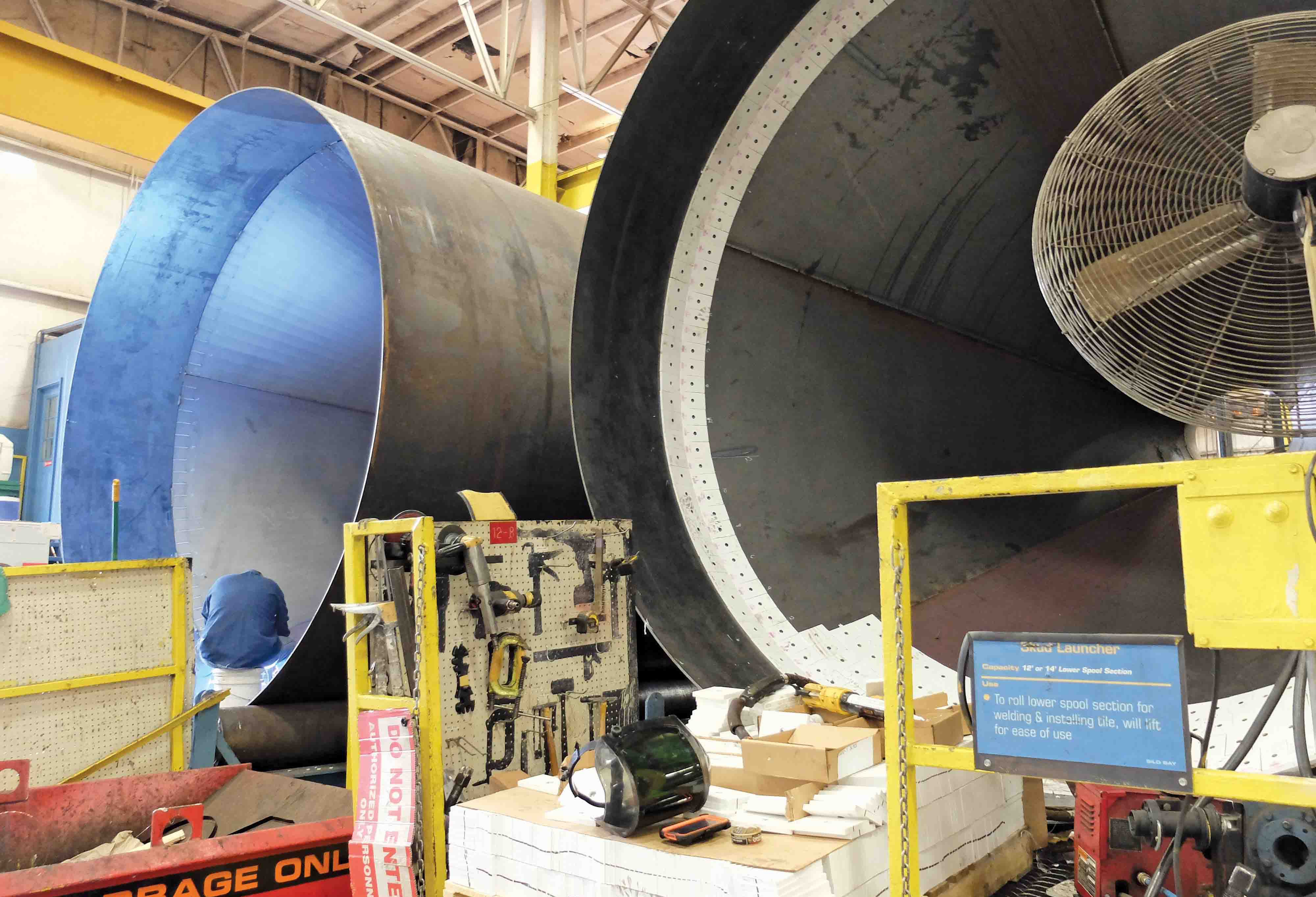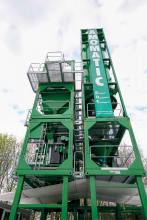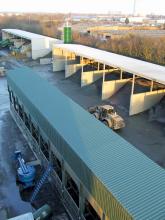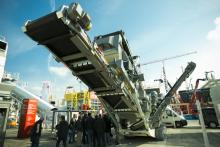Asphalt production is a complex process featuring many variables - Mike Varner, chief engineer at Astec Inc discussed methods with Mike Woof
Asphalt production in a black art in more ways than one. It involves a complex process of mixing bitumen with aggregates under temperature and optimising this operation is crucial to maximise quality. But with so many variables, determining exactly what is going on inside an asphalt plant involves extensive research, sophisticated computer modelling and the use of a

Steep angles in the cones reduce material segregation while ceramic tiles reduce wear
Asphalt production is a complex process featuring many variables - Mike Varner, chief engineer at 1250 Astec Inc discussed methods with Mike Woof
Asphalt production in a black art in more ways than one. It involves a complex process of mixing bitumen with aggregates under temperature and optimising this operation is crucial to maximise quality. But with so many variables, determining exactly what is going on inside an asphalt plant involves extensive research, sophisticated computer modelling and the use of advanced technologies.
In Europe, batching plant technology is widely used and firms such as6791 Ammann, 8411 Amomatic, 167 Benninghoven, 208 E-MAK, 8346 Günter Papenburg, 246 Intrame, 1177 Lintec and 273 Marini have been developing solutions to increase the use of RAP in this type of equipment. However, in the US, the higher paving speeds employed require large quantities of asphalt. As a result, much of the US asphalt production market relies on large continuous type asphalt plants, with Astec Inc being a leading player in the sector.
Mike Varner is chief engineer at Astec Inc and explained the difficulty in visualising and optimising asphalt production processes. He said, “We are in a very complex industry that’s hard to quantify because there are so many variables.”
The Double Barrel drum has long been a key machine for Astec’s asphalt plant range and is shorter and with a larger diameter than a conventional counterflow asphalt drum. “This has the highest RAP capacity of all of our plants,” Varner said.
Over time the Double Barrel has been modified extensively and there are also a number of versions available, including the HR (high RAP) and XHR (external mixer, high RAP) variants. The XHR variant is particularly well-suited to producing quality asphalt using RAP according to Varner as it can handle up to 70% of RAP in the feed.
The heat transfer process is of particular importance during asphalt production as this is crucial for ensuring the aggregate becomes coated correctly, and Varner said, “The thermodynamics is easy. Getting the heat to be in the right time, that is difficult.”
In certain mixes this problem of heat distribution can be exacerbated by the size of the aggregates and the surface area of the materials. Virgin aggregates typically are of a comparatively large grain size and feature a small surface area by comparison with recycled feed. Varner explained that ensuring the heat transfer process is efficient poses challenges. Because the fines in the feed have a larger surface area they will heat up more quickly. And he said that around 72% of the heat transfer to the larger stone occurs when these are lying in a bed of fines.
Varner explained that as the percentage of RAP in the mix increases, so the complexity of the asphalt production process also increases in direct proportion.
There are various ways of ensuring that the larger stones are heated to the correct temperature. One option is to use more heating in the plant and with fuel being comparatively cheap at present, this is a
fairly inexpensive approach. He added that although fuel prices will increase over time, the cost of heating the plant will remain less of an issue. Of more importance is the risk of damaging the plant by overheating the baghouse through using too much heat energy.
To protect the baghouse from overheating, the operator may opt to open the door at the end of the drum, but pulling cold air into the system can result in a significant reduction of throughput. However, he said that by using the firm’s variable speed drum and latest new flight design, Astec can control the heat more accurately, without needing to open the door at the end of the drum.
Varner explained that coating problems often occur when handling unusual mixes such as certain types of SMAs or open grade friction courses. He added that using new flights and being able to change the speed of the drum is also vastly preferable to the previous task of having to change the flights inside the drum at the end of a shift. This is a job that is unpleasant for the service technician to carry out due to the retained heat inside the drum and which also requires costly downtime. “Instead, the producer is able to adjust the speed on the fly.”
Astec has improved the flight design, which increases material dispersion efficiency in the drum and helps with the heat transfer when used in combination with the variable frequency drive drum.
The firm also now makes the flights from stainless steel for all of its asphalt drums. Ensuring that the flights are corrosion resistant is a key issue and particularly when using furnace slag in the feed, as this can be corrosive to ordinary grades of steel. Avoiding the downtime for flight replacement quickly offsets the marginal increase in cost for the more expensive stainless steel.
The firm has also developed the Intellipac system which is able to determine the moisture content in the RAP. This system can be used to capture the settings made by an experienced plant operator and provide the equivalent of an assisted drying package for a less experienced operator. And the feature is particularly important when using RAP because there is so much more going on during mixing.
Dust handling also presents a major issue and Varner said, “It takes up the voids in the mix so understanding where it goes is very important.”
Some fines can recirculate inside the drum and can assist in heat transfer, but if there are too many fines in the mix it can cause a problem with regard to coating. Meanwhile, ‘shaggy dog’ chains are now fitted on the inside of the drum to prevent dust from building-up and breaking off in lumps into the mix.
In addition Astec has developed new silos. Varner said, “They’re guaranteed for four days' storage but we’ve had customers store material for up to eight weeks.” Varner pointed out that heat loss is not the main the issue with regard to storage and added, “It’s about oxidation.”
Oil filled gate seals are installed at the bottom of these units, which prevents oxygen from entering and rising up through the silos. Meanwhile, material segregation is also reduced by the design of the feeder cones, which feature steep angles of 70°. Ceramic tiles that are 12mm thick are fitted at the base of the cone also, as this helps reduce wear. These are welded in place, with silicon bonding and then placed in the gaps as a sealant. For most customers the ceramic tiles are fitted for the first 610mm of the cone, although some buyers do request the tiles to be installed all the way to the throat.
The silos are offered with capacities from 100-300tonnes and are wrapped in an insulating material and then given and exterior cladding of aluminium sheeting.
And customers can select burners with a range of different fuel types including natural gas, diesel, waste oil, vapourised propane, and coal dust. Computational fluid dynamics has been used by the firm to develop the advanced burners with ultra-low NOx emissions and Varner said. “We’re always looking at ways to better understand how the machines work.”
Asphalt production in a black art in more ways than one. It involves a complex process of mixing bitumen with aggregates under temperature and optimising this operation is crucial to maximise quality. But with so many variables, determining exactly what is going on inside an asphalt plant involves extensive research, sophisticated computer modelling and the use of advanced technologies.
In Europe, batching plant technology is widely used and firms such as
Mike Varner is chief engineer at Astec Inc and explained the difficulty in visualising and optimising asphalt production processes. He said, “We are in a very complex industry that’s hard to quantify because there are so many variables.”
The Double Barrel drum has long been a key machine for Astec’s asphalt plant range and is shorter and with a larger diameter than a conventional counterflow asphalt drum. “This has the highest RAP capacity of all of our plants,” Varner said.
Over time the Double Barrel has been modified extensively and there are also a number of versions available, including the HR (high RAP) and XHR (external mixer, high RAP) variants. The XHR variant is particularly well-suited to producing quality asphalt using RAP according to Varner as it can handle up to 70% of RAP in the feed.
The heat transfer process is of particular importance during asphalt production as this is crucial for ensuring the aggregate becomes coated correctly, and Varner said, “The thermodynamics is easy. Getting the heat to be in the right time, that is difficult.”
In certain mixes this problem of heat distribution can be exacerbated by the size of the aggregates and the surface area of the materials. Virgin aggregates typically are of a comparatively large grain size and feature a small surface area by comparison with recycled feed. Varner explained that ensuring the heat transfer process is efficient poses challenges. Because the fines in the feed have a larger surface area they will heat up more quickly. And he said that around 72% of the heat transfer to the larger stone occurs when these are lying in a bed of fines.
Varner explained that as the percentage of RAP in the mix increases, so the complexity of the asphalt production process also increases in direct proportion.
There are various ways of ensuring that the larger stones are heated to the correct temperature. One option is to use more heating in the plant and with fuel being comparatively cheap at present, this is a
fairly inexpensive approach. He added that although fuel prices will increase over time, the cost of heating the plant will remain less of an issue. Of more importance is the risk of damaging the plant by overheating the baghouse through using too much heat energy.
To protect the baghouse from overheating, the operator may opt to open the door at the end of the drum, but pulling cold air into the system can result in a significant reduction of throughput. However, he said that by using the firm’s variable speed drum and latest new flight design, Astec can control the heat more accurately, without needing to open the door at the end of the drum.
Varner explained that coating problems often occur when handling unusual mixes such as certain types of SMAs or open grade friction courses. He added that using new flights and being able to change the speed of the drum is also vastly preferable to the previous task of having to change the flights inside the drum at the end of a shift. This is a job that is unpleasant for the service technician to carry out due to the retained heat inside the drum and which also requires costly downtime. “Instead, the producer is able to adjust the speed on the fly.”
Astec has improved the flight design, which increases material dispersion efficiency in the drum and helps with the heat transfer when used in combination with the variable frequency drive drum.
The firm also now makes the flights from stainless steel for all of its asphalt drums. Ensuring that the flights are corrosion resistant is a key issue and particularly when using furnace slag in the feed, as this can be corrosive to ordinary grades of steel. Avoiding the downtime for flight replacement quickly offsets the marginal increase in cost for the more expensive stainless steel.
The firm has also developed the Intellipac system which is able to determine the moisture content in the RAP. This system can be used to capture the settings made by an experienced plant operator and provide the equivalent of an assisted drying package for a less experienced operator. And the feature is particularly important when using RAP because there is so much more going on during mixing.
Dust handling also presents a major issue and Varner said, “It takes up the voids in the mix so understanding where it goes is very important.”
Some fines can recirculate inside the drum and can assist in heat transfer, but if there are too many fines in the mix it can cause a problem with regard to coating. Meanwhile, ‘shaggy dog’ chains are now fitted on the inside of the drum to prevent dust from building-up and breaking off in lumps into the mix.
In addition Astec has developed new silos. Varner said, “They’re guaranteed for four days' storage but we’ve had customers store material for up to eight weeks.” Varner pointed out that heat loss is not the main the issue with regard to storage and added, “It’s about oxidation.”
Oil filled gate seals are installed at the bottom of these units, which prevents oxygen from entering and rising up through the silos. Meanwhile, material segregation is also reduced by the design of the feeder cones, which feature steep angles of 70°. Ceramic tiles that are 12mm thick are fitted at the base of the cone also, as this helps reduce wear. These are welded in place, with silicon bonding and then placed in the gaps as a sealant. For most customers the ceramic tiles are fitted for the first 610mm of the cone, although some buyers do request the tiles to be installed all the way to the throat.
The silos are offered with capacities from 100-300tonnes and are wrapped in an insulating material and then given and exterior cladding of aluminium sheeting.
And customers can select burners with a range of different fuel types including natural gas, diesel, waste oil, vapourised propane, and coal dust. Computational fluid dynamics has been used by the firm to develop the advanced burners with ultra-low NOx emissions and Varner said. “We’re always looking at ways to better understand how the machines work.”









